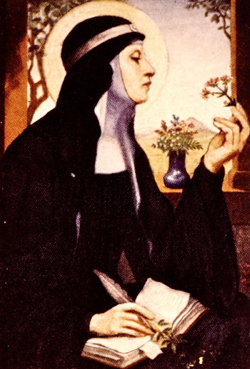Today’s history-I-never-knew blog post is from the annals of religion. Or, maybe it’s from the annals of medicine. You can decide.
It took almost a thousand years for the Catholic Church to get it right about Saint Hildegarde of Bingen (1098-1179.) She’s known as “The Sybil of the Rhine” for her poetic prophecies. She was already canonized a saint, but it wasn’t until 2012 that Pope Benedict XVI named the learned Hildegarde a Doctor of the Church. She’s only the fourth woman to be so designated.
I’d say she deserves it. When it came to health care matters, she knew what was good for you.
According to “Drinking with the Saints: A Sinner’s Guide to a Holy Happy Hour,” Hildegarde was exceptionally wise, “with a keen insight into moral psychology and an avid interest in many subjects, including medicine. An important example of Hildegarde’s wisdom is her high regard for wine and beer.”
In her treatise “Causes and Cures,” Hildegarde’s prescription for treating a sick person is “Cerevisiam Bibat.”
Translation: “Let him drink beer.”
She explains why: “For beer fattens up man’s flesh and bestows a beautiful color to his face on account of the strength and good vitality of the grain. But water debilitates man and, if he is sick, sometimes produces a bluish discoloration around the lungs. For water is weak and does not have a strong power.”
Brilliant. Why didn’t they think of that before? Holy and wise she was, indeed. But medicine was hardly her only subject. She wrote fifteen books and composed dozens of hymns; she is one of the most renowned composers of sacred monophony, which will be familiar to people of my generation as Gregorian Chant.
Hildegarde founded two abbeys in Germany. They were dissolved in a nineteenth-century wave of secularization, but Benedictine nuns later re-established one as Eibingen Abbey. It is also known as Abtei St. Hildegard, and it is a “Klosterweingut,” a monastic winegrowing estate. They make their own Riesling wine, which is unfortunately not distributed beyond the borders of Germany.
The wine from that abbey has nothing to do with the Blue Nun brand. You may remember how popular Blue Nun used to be, and the radio ads for it by Stiller and Meara. It was called a “Liebfraumilch,” or “Dear Lady’s Milk,” and the nuns in blue habits that are associated with it were garbed in that color as a display of devotion to the Virgin Mary.
Blue Nun was invented in the 1920s by the H. Sichel Schöne Company. The Blue Nun name and labeling was a branding maneuver to help boost exports. Up until that time, German wine labels were printed in a typeface called Fraktur, which was difficult to read. Blue Nun’s simplified visuals and graphics were a welcome change. The first nuns depicted on the labels actually wore brown habits, not blue ones. But in the United States, even they couldn’t be shown initially because the Bureau of Alcohol, Tobacco, and Firearms prohibited images of nuns.
There’s a Hildegard wine put out by Au Bon Climat winery of Santa Barbara, California, but it has nothing to do with Hildegarde of Bingen. It’s named for Empress Hildegard, the wife of Charlemagne. She lived a couple of hundred years before our admired friend from Bingen. According to the Au Bon Climat website,
“The name Hildegard is a salute to the history of Burgundy and to her husband the King of the Franks, Charlemagne. During his rule in the early 800s the importance of wine and viticulture exploded. The Catholic Church and Charlemagne ruled most of Europe and both were interested in wine and viticulture. The Church needed wine for the Eucharist and under Charlemagne more and more vineyards were planted in Burgundy. Charlemagne brought civilization and order back after the dark ages. Part of this rebirth was wine production.”
You might have a little more luck obtaining one of two Réserve Hildegarde beers, a blonde and an ambree, from the Brewery St. Germain in Aix-Noulette, France. They make the beers as “a special tribute to Hildegarde of Bingen, who lived and loved hops more than 800 years ago.”
So that’s my story of Hildegarde of Bingen. Kudos to Pope Benedict for his better-late-than-never accolade to her.
And let’s heed her excellent recommendation and raise a stein in her honor: “Cerevisiam Bibamus!”

Leave a comment